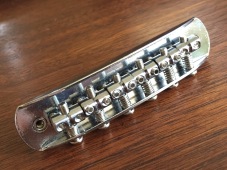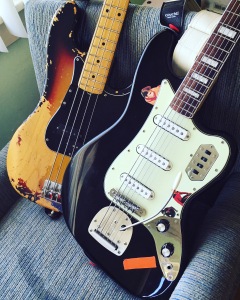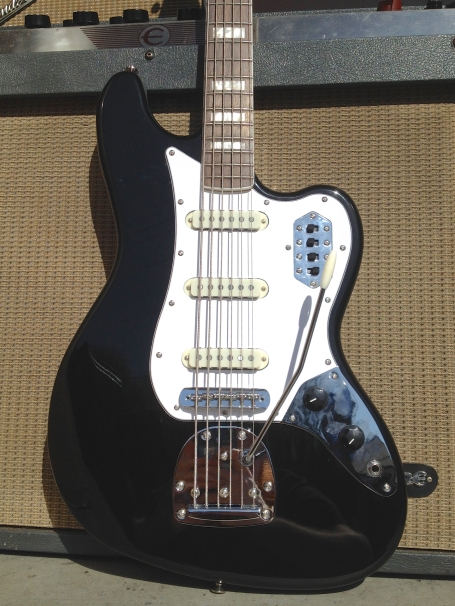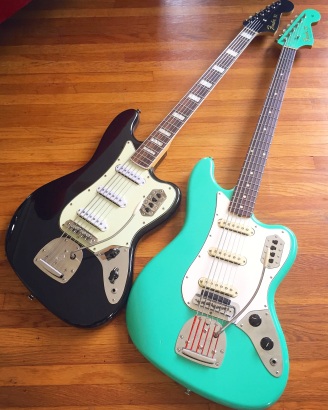
My Squier VI lounging with Paul Frank’s amazing Custom Shop model, strung with Gabriel Tenorio strings
While Fender’s Jazzmaster and Jaguar seem more popular than ever, the Bass VI still seems mysterious, or at the very least, under-appreciated. Players seem confused by its mere presence in the catalog: Is it a bass? Is it a guitar? Is it a baritone?
Let’s clear up the confusion right now: The Bass VI is a bass guitar in the strictest sense. Tuned E to E a full octave lower than a standard guitar, the VI is an incredibly versatile instrument that’s as well-suited for familiar chord shapes as it is for punchy bass lines.
Right now, the easiest way to get into a VI is the Squier Vintage Modified model. Fundamentally a great instrument, the Squier VI ticks all of the right boxes for me: it has Jaguar-style pickups and the all-important fourth Bass Cut switch, it’s affordable, and it’s damn fun to play. We’re still talking about an import model, so if you pick one up and find it lacking, I’m here to provide a handy upgrade guide to the “ba-VI” of “VI-sessfully” upping your Squier’s “VI appeal” into a machine for making “mu-VI.” (My deepest apologies for how poorly those puns worked.)
The first mod I’m going to suggest can hardly be called a mod at all, but believe you me, it’s crucial.
STRINGS
Far and away, the most common complaint with current Bass VI models is that the low E string lacks tension. You’ll hear it described as “floppy” or “sloppy,” and those adjectives sum it up nicely. It feels unbalanced and just can’t stand up to aggressive picking.
The problem with your Bass VI’s low E is thanks to a too-light gauge of string. When Fender released the Bass VI in 1961, the standard set was made up of strings gauged .026”-.095”, and that .095” is key here. At some point in the recent past, the low E string changed to .084” which is woefully under-built for the task. A .095” E is going to feel taut, stable, and will gleefully accept heavy attack, whereas the lighter string ends up feeling, well, just as described in the paragraph above.
In my view, the most essential mod you can perform on your VI is installing a heavier, more balanced string set. Even without upgrading the bridge or swapping pickups, this very simple and easily overlooked tweak can tighten up the whole instrument and bring back the low end that’s so sorely missing with the stock strings.
Because this information doesn’t seem to be collected anywhere, here’s a handy shortlist of string makers that offer a good set of VI strings with adequately heavy E string, which I’ll update as I stumble upon them. The only set Fender currently offers is gauged .024″-.084″, sadly.
La Bella (Flats and Rounds)
Kalium (Rounds, tons of options)
Gabriel Tenorio String Company (Rounds and Gabriel’s new Ground Wounds)
Or, if you want a genuine set from the 1960s
BRIDGE
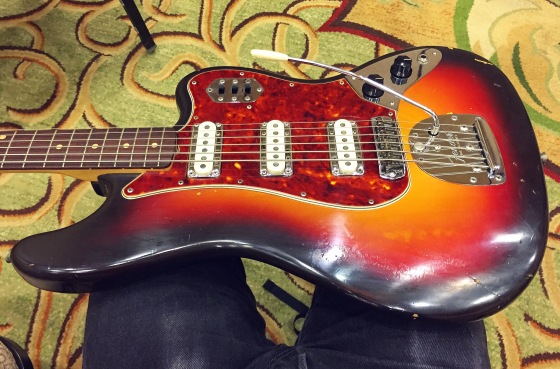
An original ’62 Bass VI that I recently fell in love with at the Fretboard Journal Summit, courtesy of Gryphon Stringed Instruments
If you ever have a chance to inspect a vintage Bass VI, you’ll notice that the original bridge is much wider than the one found on most reissues, which is just a standard offset bridge slapped on likely due to the costs of tooling-up for such a niche item. That original 1” width is a big part of the Bass VI functionality puzzle, which translates to more flexibility when it comes to intonation. Original examples have nearly twice the saddle travel as the current part, and with the Bass VI’s 30” scale, every little bit is precious.
The bridge found on the Squier Bass VI is essentially the same as the other VM offsets, save for the adjustable Mustang-style saddles, which have deep grooves and the ability to set the radius of the strings to match the fretboard. It does, however, have a propensity to rattle around so much that even correct offset setup techniques may not quell it. (See my Demystifying series for more info)
What to do? Track down an original bridge from the 1960s or 1970s? Nah, Staytrem’s got you covered with their fantastic and appropriately wide Bass VI bridge. If you’re looking for a stable bridge that’ll intonate for sure, this is the way to go. I have a Mastery on my personal Squier, and while it does intonate perfectly for me, your mileage may vary depending on string gauge and type as well as setup.
TREM
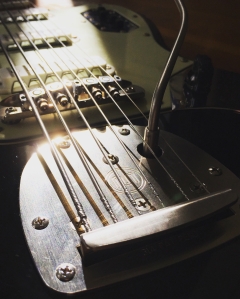 As I mentioned in my recent article on the J.Mascis model, if you’re planning on using the vibrato you really should upgrade this part. Import vibratos are made of inferior metals and often have manufacturing flaws that render them less stable than their US-made counterparts.
As I mentioned in my recent article on the J.Mascis model, if you’re planning on using the vibrato you really should upgrade this part. Import vibratos are made of inferior metals and often have manufacturing flaws that render them less stable than their US-made counterparts.
A great solution here is obtaining a Fender AVRI/AV65 vibrato, especially if you’re on a budget. I’ve chosen the Mastery Vibrato for my own specifically because of the heavy-duty spring Mastery uses, which replicates the sturdier feel of early 1960s units and really stands up to the extra tension of those thick strings.
NUT
As you might expect, the nut work on these instruments is passable, but not great. The soft plastic used wears easily, and the slots are often too tight even for the string gauge used at the factory. I’ve also seen a number of them with poor string spacing, but hey, I don’t expect perfection on a sub-$500 instrument.
I highly recommend having the nut replaced by a competent tech in the material of your choice; my preference is bone. And for those of you that use the vibrato, a properly-cut nut is your best defense against tuning issues.
ELECTRONICS
The electronics in the Squier Vintage Modified series are, understandably, on the cheap side of things. I’ve seen and heard of a number of VMs that had wiring issues or faulty parts right out of the box, so if you’re going to be using this instrument heavily I would insist that you have the instrument rewired with higher quality pots, switches, capacitors, and even replace the jack while you’re at it. Not only will you end up with an instrument you can really trust, you’ll also have better sound as a result.
Look to CTS, Bourns, or my good friends at Emerson Custom for pots, Switchcraft for the jack and switches, and any number of options exist for capacitors. Most of these parts can be found via AllParts or Angela.
Note: US parts will require enlarged holes on the volume-tone control plate.
PICKUPS
While I confess that you can get by with the Squier in its stock configuration, let’s be honest: there are better pickups out there. They’re a little trebly, a bit noisy, and too weak on output to keep up with other basses. It’s well worth your time to explore the myriad pickup options that exist in today’s market, but where to start?
In my mind, Curtis Novak has his finger firmly on the pulse of offset guitars’ unique capabilities, and he’s the first person I bring up when a customer has a specific sound in their head. From traditional sounds to obscure designs stuffed into familiar covers, Curtis excels at wringing every last drop of tone from your instrument.
For Bass VI, he offers both the early ’61-’62 Jack Bruce-style pickups and the Jaguar-style pickups that came as standard on the model from 1962 onward. However, if you’re looking for something different, I’m sure Curtis could wind up a trio of his Jaguar-sized Lipsticks, some unique Gold Foils, or even something humbucking if you’re that kind.
Another good option would be the fantastic pickups made by our friend Jaime of At The Creamery. He offers a VI set with much higher output than the stock pickups, and with custom options if desired. Jaime does exceptional work!
On my personal VI, I started out by building a set out of three Fender AV65 Jaguar pickups, which I really like. They’re affordable and great-sounding pickups for the price, but ultimately, a little too bright for my tastes. If you need a good Tic-Tac sound, this would be a great way to go. If you create a set out of three separate pickups, do pay attention to output in each position as well as polarity to make sure they all play well together.
Currently, my VI is loaded with a set wound by our good friends a Lollar Pickups, which have a bump in midrange and output, and they really keep up with my other instruments no matter the setting. Plenty of bass on tap and clarity through any amp. I’m a huge fan of Lollar Pickups.
TUNERS
Prepare to be amazed: there’s no good reason to toss these. The Kluson-style tuners you find stock on the Squier VI are great. On the many examples I’ve had across my bench, I have never found them to be problematic. Keep them.
LINE VI
When Squier introduced their take on the VI, I was immediately excited. At the time, the VI wasn’t an instrument I was keen to spend a lot of money on, simply because I didn’t think I’d be using it heavily. Squier made that sound accessible and did so with a lot of bang for the buck. When you mod this instrument, it isn’t so much a lipstick-on-a-pig scenario, you’re genuinely taking a good instrument and making it better.
To that point, I recently joined my good friends Vanessa and Sarah, a duo better known as Leo Leo. The LA-based contemplative rock-pop outfit plays complex, beautiful music that’s as energetic as it is challenging; they are one of my favorite bands. When they asked me to tour with them on bass, I have to admit that I was overjoyed and overwhelmed, especially with just a week to learn ten songs. It was a lot of work, but I’m so proud of the noise we made together at those shows.
At the center of my bass sound: my trusty Squier VI. I plugged into a borrowed Salvage Custom board (thank you, Gabriel!) populated with pedal necessities run through a mini SVT. Night after night, that thing performed beautifully and never let me down. Even as we rehearsed, it became clear that the VI was the sound. It proved to be such a bruiser that next time, I may leave my ’73 Precision Bass at home.
Each time I took it out of its case, I was immediately greeted with questions from perplexed onlookers that wondered about my weird bass. I showed it off proudly and handed it over to person after person, none of whom could believe what they were playing was a lowly Squier. There was only one occasion before a show where a churlish bassist chided me for playing––and I quote––a “piece of shit.”
I’m happy to say that I proved him wrong that night. I’m proud to play my Squier.

